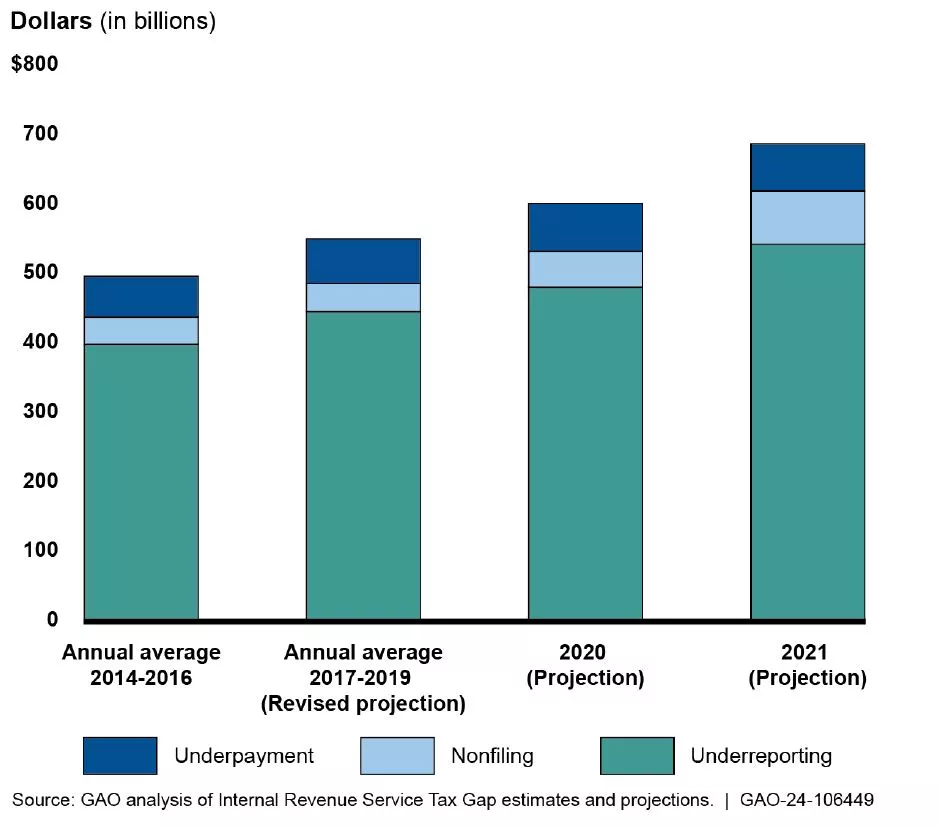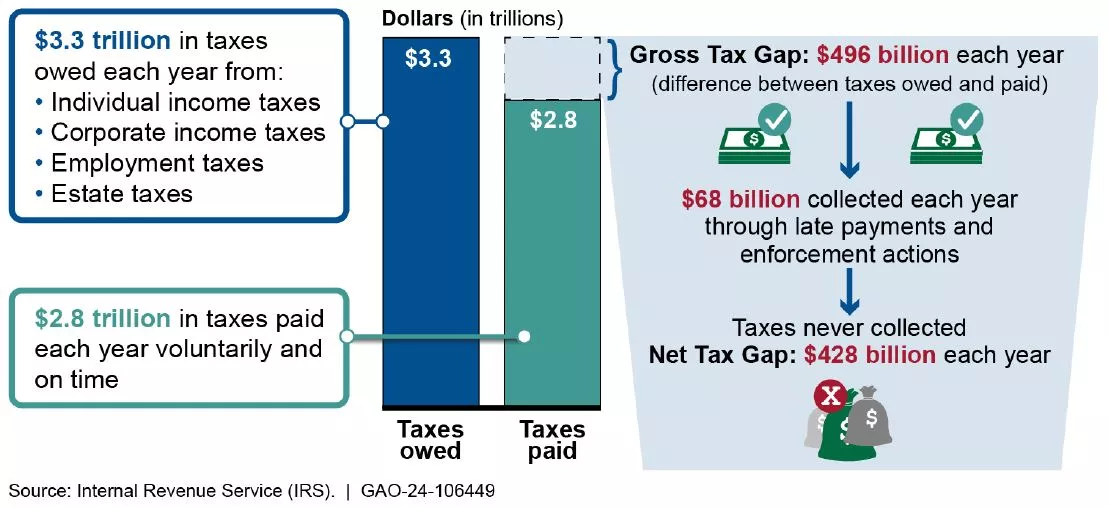Artificial Intelligence May Help IRS Close the Tax Gap
Hundreds of billions of dollars are potentially missing from what should be collected in taxes each year. Known as the “tax gap,” this money is the difference between what is owed and what is paid by taxpayers. The tax gap has been a problem for decades and it is growing larger.
IRS’s use of artificial intelligence may help close the gap. Today’s WatchBlog post looks at our new report about this effort.
Image

How big is the tax gap and how does IRS currently estimate it?
IRS’s most recent estimate of the tax gap puts the amount owed and not paid at about $496 billion each year (for 2014-2016). For 2021, the tax gap was expected to grow to $688 billion. That’s billions of missing dollars that could fund federal programs and projects—everything from Medicare and Medicaid to transportation improvements. This is also money that could be used to reduce our national debt, which is on an unsustainable path.
IRS’s Annual Average Tax Gap Estimates 2014-2016
Image

You might be asking, why are IRS’s most recent estimates a decade old? Or why IRS is projecting missing payments for years that have already passed? The time lag is the result of the time it takes to audit taxpayers’ returns. Once taxpayers file returns, the IRS must select returns to be audited, complete these audits, and validate results before a final estimate can be created.
Artificial intelligence (AI) may provide some additional tools to help IRS better understand and estimate the tax gap.
How is artificial intelligence helping IRS reduce the tax gap?
Using new AI models could help IRS identify those taxpayers who are most likely to skip out or not pay the taxes they owe. AI won’t solve all of IRS’s tax gap problems. IRS will need to use multiple approaches to reduce the tax gap. But we looked at three areas where AI is currently in use and could help.
Annual audits. Each year, IRS selects a group of taxpayers to audit as part of its research into tax compliance trends. AI models are already being used to help select a representative sample of the taxpayer returns to audit. AI is also being used to identify returns that are more likely to have errors and are more likely to owe additional taxes. After these audits, as described above, IRS creates an estimate of the tax gap. This is important for helping IRS to better understand situations in which taxpayers aren’t complying with tax laws. While IRS’s efforts with AI show promise, we think it could do more to document these AI models to ensure they are transparent and implemented consistently in the coming years. Otherwise, IRS risks not being able to explain how it selected taxpayers for these more burdensome audits.
Refundable credits. Currently, IRS uses both manual processes and AI to help select taxpayers claiming refundable credits, such as the Earned Income Tax Credit, for audit. Beginning this year, IRS plans to use a new AI model to help it identify taxpayers for audit that are more likely to owe additional taxes. IRS officials told us the results from the pilot study of this model indicate that it more effectively finds risky taxpayers than the previous model. However, we think IRS can do more to improve the new model's ability to find the highest risk taxpayers.
Partnership audits. More businesses are being organized into partnerships, which allows them to pass income and losses to their partners instead of being taxed as corporations. The number of large partnerships has increased substantially in recent years (by nearly 600% between 2002 and 2019). This shift has made it more difficult for the IRS to identify taxable income and catch potential tax cheats.
IRS audits few large partnerships’ tax returns because they are complex. And when IRS does audit them, the result is often no change to the audited return. IRS currently uses two AI models to help prioritize partnership returns for audit. The models are intended to help select the highest risk large partnership returns for audit. But we think more could be done to address design weaknesses that may limit these models’ ability to objectively identify the most high-risk returns and improve audit selection over time. We made recommendations to improve the design of these models so they might help IRS better select noncompliant partnership returns to audit and improve the results of these audits.
We will continue monitoring IRS’s use of AI to address the tax gap, as well as its other efforts. Learn more about the tax gap.
- GAO’s fact-based, nonpartisan information helps Congress and federal agencies improve government. The WatchBlog lets us contextualize GAO’s work a little more for the public. Check out more of our posts at GAO.gov/blog.






